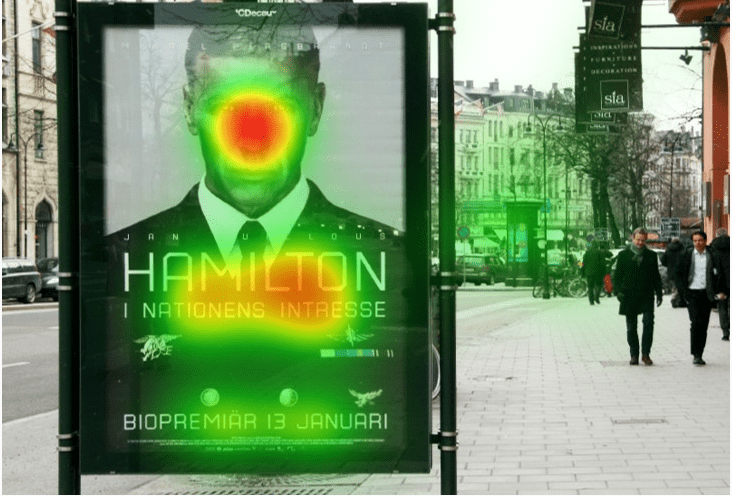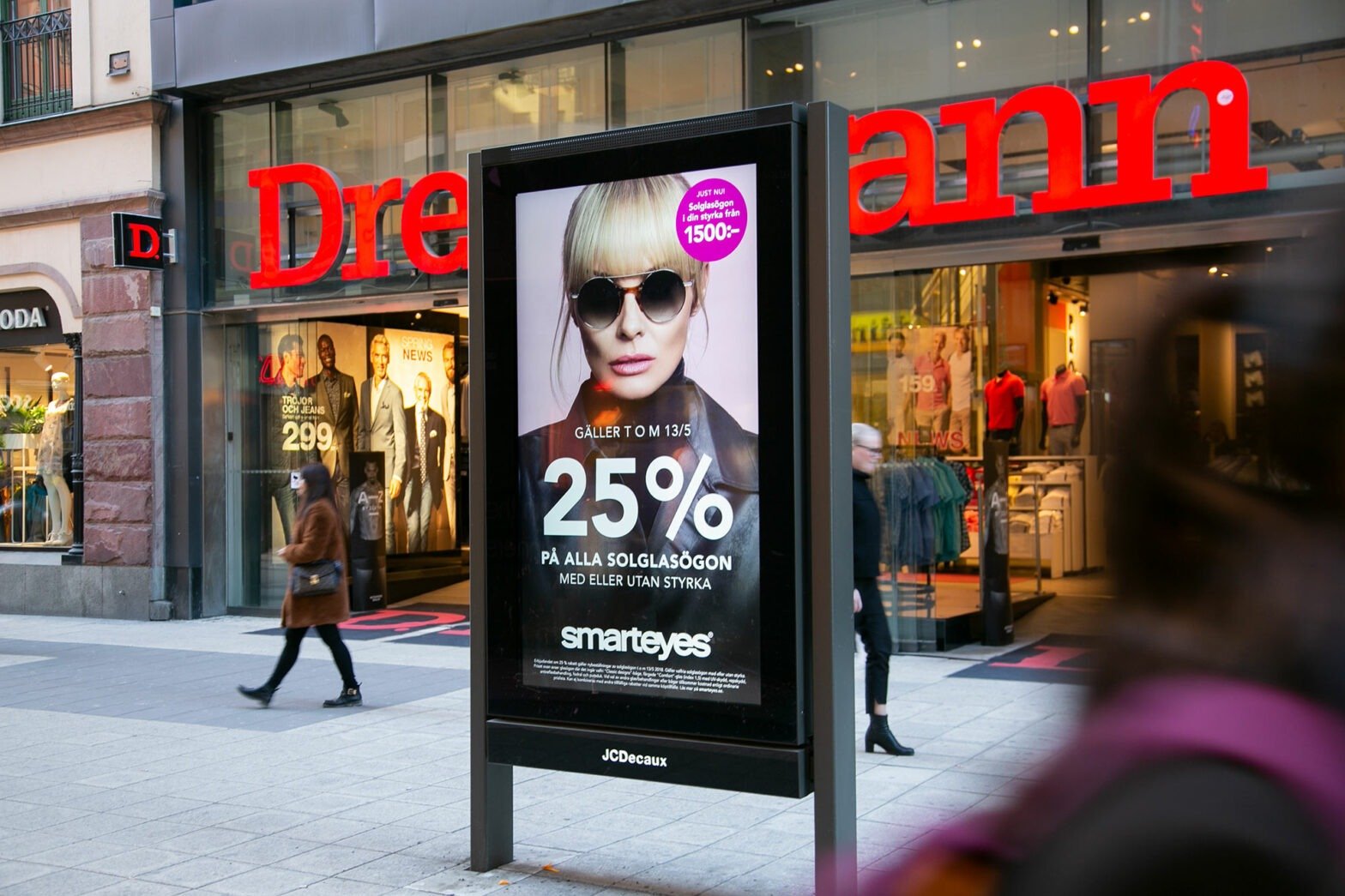Range, frequency, VAC... what does all that really mean? We know it can get a bit complicated. Here we try to clarify all the concepts and help you with everything you need to know, to make the most of your campaign.
When planning an outdoor campaign, it is important to understand the opportunities and challenges of the medium. By optimising the creative design and creating a good interaction with other media, the chances of achieving a successful result are increased.
Creative Guidelines
Clearest wins! The most successful outdoor advertisement is the one that conveys a simple and clear message that the recipient can understand in a maximum of three seconds. Here are some of the key golden rules of outdoor advertising. And remember, these are guidelines. If you're a seasoned outdoor advertiser, breaking every rule in the book can be just as successful.
Red thread
Feel free to use different motifs on the posters to make the campaign more vibrant - but make sure there is a common thread (e.g. same colour, photo motives, font, etc.). The recipient should be able to see that the different units belong to the same campaign.
Challenge and engage
A design that surprises and arouses emotions attracts attention. What do you want the recipient to do/feel/think? Whatever your message, call to action is important and the more you manage to engage and touch with your campaign, the better the effect it will have.
Sender - logo placement
Remember that the sender and other important information should be visible even if something obscures the poster (e.g. people, bicycles, snow piles or construction debris). Therefore, the logo needs to be large and clear and should preferably be placed high up.
Familiar faces and eye contact
Take advantage of recognition by using familiar faces! A known person usually gives high observational power. Eye contact is also important; it is a known fact that eyes are drawn to the eyes of others.
Clarity
"A picture is worth a thousand words" is a guiding principle in outdoor advertising. Combine a clear image with a clear message and a clear link to the product or service. That way the message gets across in the best possible way.
Contrasts
Use clear contrasts and colours that are clearly visible - this creates attention. The image should not be too dark. The message should be in a colour that stands out against the background. Use colours that stand out depending on the season - for example, avoid white in winter, green in summer and yellow, orange and red in autumn.
Font size
Outdoor advertising needs to be perceived quickly in comparison to, for example, a newspaper ad. Therefore, the choice of font and size is important. Remember to use strong, easy-to-read typography in the headline (which should of course be kept short).
Simplicity
Everything on the poster should be easy to see. In other words: BIG TEXT and not too much information. Outdoor advertising is fast communication. The further away from the recipient, the more important speed and clarity. Therefore, prioritise a concise, relevant message.
Test fishing
Do you have an idea for an outdoor campaign that you would like to try out? JCDecaux offers a unique opportunity to test a campaign idea before it goes live by test posting! Trial posting simply means that we print your campaign idea or display it in our digital format Digisize, we meet up in town at one of our boards. This way you can see if there is anything that needs fine-tuning to give the campaign maximum impact. Interested? Contact our sales team.
Test your outdoor motifs for free with the Predict tool
The outdoor channel requires fast communication. Your message should be concise and clear to ensure your campaign reaches its target audience. Now you can test your outdoor motifs for free using the Predict tool. The tool is based on extensive neuroscience research and uses over 12,000 eye movement studies. With this tool you can see in advance how your designs will be perceived and perform in the outdoor environment.



What else can you deduce? Well, something called Cognetive Demand. Another parameter is Image Clarity. Contact us we'll tell you more about it, and test your subjects in this useful and clear tool.
FAQ
What is the best thing about outdoor advertising?
With outdoor advertising, you get high frequency at a low contact cost as your message reaches a large number of people several times during the campaign period. Outdoor advertising generates a high reach, even in a specific city. The medium is ideal for brand-building advertising as well as sales activation advertising. Outdoor advertising is also the last mass medium in a changing and fragmented media landscape.
Why choose outdoor advertising?
The outdoor advertising cannot be clicked, zapped or muted. And it's located where the many people are on the move. Our outdoor media reaches 70% of Swedens population (age 15-79) in the 25 largest cities. If you want to get your message out quickly, to many people at the same time, outdoor advertising is the best media choice.
What is OTS?
Number of times the average individual in the target group has the opportunity to come into contact with the advertising message during a campaign period on average (total number of possible contacts with the medium/individuals).
What is frequency?
The average number of times a person has the opportunity to view the campaign during the week.
How do you calculate reach?
We calculate reach in two ways; net reach is the number of unique people reached by the advertising message (a person can only be counted once) gross reach is the number of contacts (a person is counted several times)
Words we often use
Adshel
ClearChannel's name for the Eurosize format.
Backlit
Lighting on the advertising surface that illuminates the poster from behind during the dark part of the day.
Gross price
List price before any discounts.
Gross Reach
The sum of all contacts. The same person can be counted several times in addition to net reach.
CPT
Cost per thousand contacts - Kostnad för tusen contacts. Net price/number of contacts x 1000.
Distribution
The distribution of advertising space across a region.
DOOH
Digital Out Of Home - Digital outdoor advertising.
Eurosize
Outdoor product with paper format, 1185 x 1750 mm (width x height). Format suitable for advertising space in bus stops, free-standing billboards, wall-mounted advertising spaces.
NO OF EXPOS
An advertising space can have multiple exposures, e.g. if the posters alternate images.
Flow
The number of motorists and pedestrians passing by an outdoor advertising space.
Frequency
As many times as a person sees the ad campaign in a week's time.
Stand-alone
Free-standing advertising space on streets and squares, as opposed to advertising space located in a bus stop.
Fullsize
Format Pillar, 1185 x 3260 mm (width x height), portrait format.
Head on
The side of the advertising space that is angled towards the traffic and flow and therefore generates the most contacts.
Target group
A defined group of people who are interesting as recipients of marketing.
Net price
Negotiated price based on a gross price.
Net range
Indicates how many people have seen your advertising campaign. Unique contacts as opposed to gross reach.
Network
The outdoor spaces are sold in different networks/series that are distributed in Sweden's largest cities in order to provide as even a distribution as possible.
OBSmeasurements
After the campaign, you can carry out an impact measurement that provides answers to how the campaign was received in the city, whether people have noticed the campaign and been influenced by the message, etc.
Offset 4+0
Printing method where one side of the paper is printed. Works during the light season where backlighting of the poster is for a short time of the day.
Offset 4+3
Printing method where both the front and back of the paper are printed to increase contrast and colour. Particularly important during the dark period of the year when the poster is backlit most of the day.
OOH
Out Of Home - Outdoor advertising.
OTS
Opportunity To See. The number of passers-by who have the opportunity to see the surface.
Outdoor Impact
Survey tool/methodology that produces reach and frequency figures for outdoor media.
Pass (area/week)
Average number of impressions per advertising space in a campaign/series or for a format in a region.
Passages
The number of motorists and pedestrians passing by an outdoor advertising space.
Potential measurements
Potential measures are developed before the start of the campaign via Outdoor Impact, i.e. a report on what the desired campaign could potentially achieve.
Preliminary booking
A customer has provisionally booked an outdoor series. If someone else wants to book the same series, the customer has 48 hours to decide whether to keep the booking, otherwise the preliminary booking is released.
ROMI
Return on media investment. What the advertising investment brings to the advertiser.
Reach
Measure of the percentage of the intended audience reached by the message.
Selectyta
Selected individual advertising space and not a network/series.
SOV
Share Of Voice. A measure of how much of the outdoor space your particular campaign represents, usually expressed as a percentage.
City information
One of the surfaces of the freestanding billboards is the city's surface where they can inform citizens with socially useful information.
Supersize
60 sqm of backlit space located on several of Stockholm's entrances and in Gothenburg. Including the E18 and E4.
VAC
Visibility Adjusted Contact. Visibility adjusted contact. The number of passers-by who should be able to see an outdoor surface according to Outdoor Impact's four survey items.
Weather protection
Other word for bus stop

